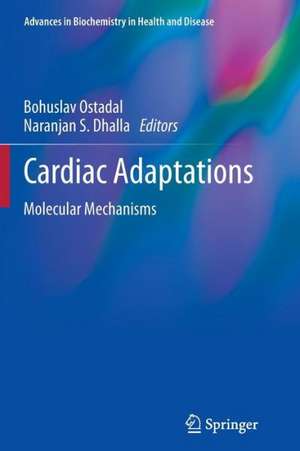Cardiac Adaptations: Molecular Mechanisms: Advances in Biochemistry in Health and Disease, cartea 4
Editat de Bohuslav Ostadal, Naranjan S. Dhallaen Limba Engleză Paperback – 9 noi 2014
| Toate formatele și edițiile | Preț | Express |
|---|---|---|
| Paperback (1) | 1104.48 lei 6-8 săpt. | |
| Springer – 9 noi 2014 | 1104.48 lei 6-8 săpt. | |
| Hardback (1) | 1120.40 lei 6-8 săpt. | |
| Springer – 12 oct 2012 | 1120.40 lei 6-8 săpt. |
Din seria Advances in Biochemistry in Health and Disease
- 18%
 Preț: 1241.55 lei
Preț: 1241.55 lei - 5%
 Preț: 1290.27 lei
Preț: 1290.27 lei - 5%
 Preț: 1291.01 lei
Preț: 1291.01 lei - 5%
 Preț: 1103.75 lei
Preț: 1103.75 lei - 5%
 Preț: 1430.35 lei
Preț: 1430.35 lei - 18%
 Preț: 1126.52 lei
Preț: 1126.52 lei - 15%
 Preț: 647.40 lei
Preț: 647.40 lei - 5%
 Preț: 1107.21 lei
Preț: 1107.21 lei - 18%
 Preț: 958.07 lei
Preț: 958.07 lei - 18%
 Preț: 1237.48 lei
Preț: 1237.48 lei - 18%
 Preț: 957.94 lei
Preț: 957.94 lei - 5%
 Preț: 1213.78 lei
Preț: 1213.78 lei - 24%
 Preț: 898.17 lei
Preț: 898.17 lei - 5%
 Preț: 670.95 lei
Preț: 670.95 lei - 18%
 Preț: 1225.48 lei
Preț: 1225.48 lei - 24%
 Preț: 835.46 lei
Preț: 835.46 lei - 5%
 Preț: 1025.14 lei
Preț: 1025.14 lei - 18%
 Preț: 1121.62 lei
Preț: 1121.62 lei - 5%
 Preț: 1018.44 lei
Preț: 1018.44 lei - 5%
 Preț: 1108.35 lei
Preț: 1108.35 lei - 5%
 Preț: 1320.04 lei
Preț: 1320.04 lei - 5%
 Preț: 1114.91 lei
Preț: 1114.91 lei - 5%
 Preț: 1388.52 lei
Preț: 1388.52 lei - 5%
 Preț: 1321.45 lei
Preț: 1321.45 lei - 18%
 Preț: 964.71 lei
Preț: 964.71 lei - 5%
 Preț: 1119.47 lei
Preț: 1119.47 lei - 5%
 Preț: 1116.73 lei
Preț: 1116.73 lei
Preț: 1104.48 lei
Preț vechi: 1162.61 lei
-5% Nou
Puncte Express: 1657
Preț estimativ în valută:
211.34€ • 220.66$ • 174.91£
211.34€ • 220.66$ • 174.91£
Carte tipărită la comandă
Livrare economică 04-18 aprilie
Preluare comenzi: 021 569.72.76
Specificații
ISBN-13: 9781493900305
ISBN-10: 1493900307
Pagini: 484
Ilustrații: XVIII, 466 p.
Dimensiuni: 155 x 235 x 25 mm
Greutate: 0.67 kg
Ediția:2013
Editura: Springer
Colecția Springer
Seria Advances in Biochemistry in Health and Disease
Locul publicării:New York, NY, United States
ISBN-10: 1493900307
Pagini: 484
Ilustrații: XVIII, 466 p.
Dimensiuni: 155 x 235 x 25 mm
Greutate: 0.67 kg
Ediția:2013
Editura: Springer
Colecția Springer
Seria Advances in Biochemistry in Health and Disease
Locul publicării:New York, NY, United States
Public țintă
ResearchCuprins
Comparative Aspects of Cardiac Adaptation.- Molecular Mechanisms in Cardiac Development.- Prenatal Adaptation to Overload.- Hypoxia and Mechanical Factors Drive Coronary Vascular Development.- Cardiac Metabolic Adaptation During Postnatal Development.- Ontogenetic Adaptation to Chronic Hypoxia.- Heart and Arterial Aging.- Differences in Concentric Cardiac Hypertrophy and Eccentric Hypertrophy.- Cardiac Adaptation to Volume Overload.- Functional Adaptation during the Development of Cardiac Hypertrophy and Heart Failure in Females.- Impact of Gender and Exercise on Cardiac Adaptation to Pathological Situations.- Cardiopulmonary Adaptation to High Altitude.- Cardiac Hypertrophy in Hypertension.- Exercise Training and Adverse Cardiac Remodeling and Dysfunction in Mice.- The Athlete’s Heart.- Role of β - Adrenoceptor/Adenylyl Cyclase System in Cardiac Hypertrophy.- Role of Phospholipase C in the α1 - Adrenoceptor Mediated Cardiac Hypertrophy.- Maladaptive Cardiac Remodeling: Signal-dependent Regulation of the Fibrotic Gene Program by CLP-1 in the Hypertrophic Heart.- Role of Sirtuins in Regulation of Cardiac Adaptation Associated with Hypertrophy.- Adaptation of Cardiac and Skeletal Muscle Mitochondria to Endurance Training: Implications for Cardiac Protection.- Adenosine as an Endogenous Adaptive Cardiac Antihypertrophic and Antiremodelling Factor.- Myocardial Adaptation and Autophagy.- Modulatory Role of VEGF in Angiogenesis for Cell Survival.- The Role of CaM Kinase II in Cardiac Function in Health and Disease.
Textul de pe ultima copertă
The processes of adaptation and maladaptation play an important role in the pathogeny of serious cardiovascular diseases, such as hypertension, valvular diseases, congenital heart disease, myocardial infarction and different cardiomyopathies as well as during adaptation to exercise and high altitude hypoxia. This volume incorporates the rapidly developing basic and clinically relevant information on adaptive mechanisms, thereby contributing to the better understanding of possible prevention and therapy of life-threatening cardiovascular diseases.
The first section of this volume focuses on developmental aspects of cardiac adaptation, including chapters on comparative and molecular aspects of cardiac development, prenatal and postnatal developments, coronary vascular development, and ontogenetic adaptation to hypoxia, as well as cardiac and arterial adaptation during aging. The second section is devoted to cardiac adaptations to overload on the heart, centered around the mechanisms of cardiac hypertrophy due to pressure overload, volume overload, exercise, gender difference, high altitude, and different pathological situations. The third section of this volume highlights the roles of sympathetic nervous system with respect to α-adrenoceptor and β-adrenoceptor mechanisms in the development of cardiac hypertrophy. Cardiac Adaptations will be of great value to cardiovascular investigators, who will find this book highly useful in their cardiovascular studies for finding solutions in diverse pathological conditions; it will also appeal to students, fellows, scientists, and clinicians interested in cardiovascular abnormalities.
The first section of this volume focuses on developmental aspects of cardiac adaptation, including chapters on comparative and molecular aspects of cardiac development, prenatal and postnatal developments, coronary vascular development, and ontogenetic adaptation to hypoxia, as well as cardiac and arterial adaptation during aging. The second section is devoted to cardiac adaptations to overload on the heart, centered around the mechanisms of cardiac hypertrophy due to pressure overload, volume overload, exercise, gender difference, high altitude, and different pathological situations. The third section of this volume highlights the roles of sympathetic nervous system with respect to α-adrenoceptor and β-adrenoceptor mechanisms in the development of cardiac hypertrophy. Cardiac Adaptations will be of great value to cardiovascular investigators, who will find this book highly useful in their cardiovascular studies for finding solutions in diverse pathological conditions; it will also appeal to students, fellows, scientists, and clinicians interested in cardiovascular abnormalities.
Caracteristici
Focuses on the molecular and biochemical mechanisms, which are intimately involved in modifying the myocardial characteristics in health and disease Summarizes present knowledge of different mechanisms involved in the development of positive and negative consequences of cardiac adaptation Pulls together the rapidly developing basic and translational information on adaptive mechanisms Includes supplementary material: sn.pub/extras














